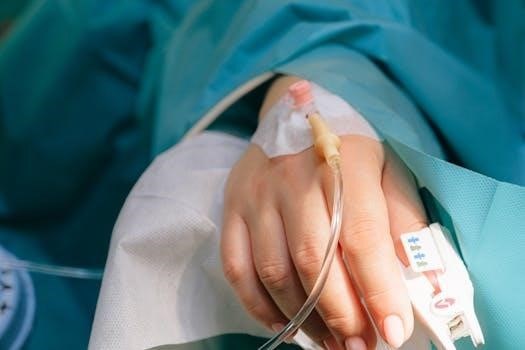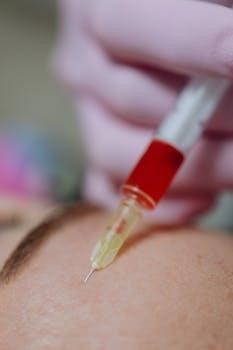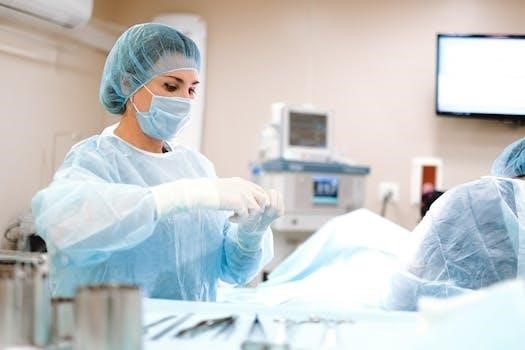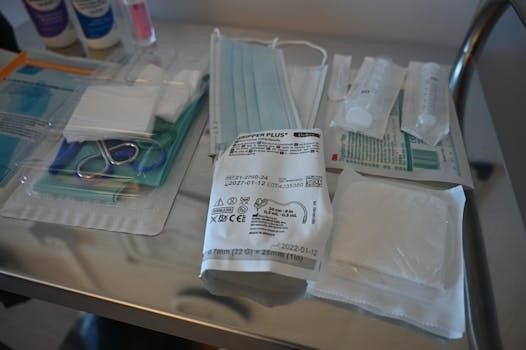Post Mortem Care Nursing Procedure
Post-mortem care is a crucial part of end-of-life care, involving respectful treatment of the deceased. It includes physical preparation, documentation, and consideration of cultural and religious beliefs. Nurses play a key role in this process, ensuring dignity and support for the family.
Initial Steps and Verification
The initial steps in post-mortem care are critical for ensuring accuracy and respect. Firstly, the nurse must verify the patient’s identity using two identifiers and confirm the death pronouncement, documenting the time of death and the physician’s contact. This verification is essential for legal and institutional purposes. Simultaneously, the healthcare team should notify necessary personnel, including the nursing supervisor, chaplain, and patient administration department, adhering to facility protocols. Furthermore, it’s important to ascertain if organ donation or autopsy procedures are to be followed, which would influence subsequent care steps. Family members should also be informed of the passing, being given sufficient time with their loved one before further care begins. The nurse must ensure that all actions are performed with utmost respect and dignity for the deceased and their family. The documentation regarding the death should include the name of the patient, the time the physician was contacted, the time the death was pronounced, and the names of the people who were present at the time of death which includes the health care personnel, family members, and friends.
Respectful Handling and Family Needs
Respectful handling of the deceased is paramount during post-mortem care, treating the patient with the same dignity and consideration as when they were alive. This involves maintaining a calm and private environment while performing care. Nurses should approach the process with compassion and empathy, especially when family members are present. It’s essential to be sensitive to the family’s needs, understanding they may have diverse cultural and religious practices. Avoid rushing the family and allow them to spend adequate time with the deceased before beginning physical care. If they wish to participate in the post-mortem care, their preferences should be respected, such as assisting with bathing or preparing the patient. Open communication is key, offering support and ensuring they know you are available to assist in any way possible. Do not interrupt their customs and practices, unless they are disturbing or causing harm to other people. It’s important to remember that this is a difficult time for the family, and providing emotional support is as important as physical care.
Physical Preparation of the Body

The physical preparation of the body is a crucial aspect of post-mortem care, requiring careful attention to detail. This includes gently cleansing the body, removing any visible soil or fluids. If present, close the patient’s mouth and place a rolled towel under the chin to prevent it from opening. If the eyes are open, gently close the eyelids using your fingertips, or use moistened cotton balls if needed. The body should be positioned supine with arms at the sides or across the abdomen, depending on cultural or religious preferences. Any medical equipment, such as tubes or catheters, should be removed only by authorized personnel, typically a Registered Nurse, following facility policy. Ensure the body is clean, dry, and dressed in a clean gown or shroud. The environment should be clean and orderly, preparing the body for viewing or transport. Throughout this process, maintain respect for the deceased, and handle the body with care and dignity, being mindful of any post-mortem changes.
Managing Post Mortem Changes
Managing post-mortem changes is an essential part of care, requiring nurses to be knowledgeable about the normal physiological processes that occur after death. One common change is rigor mortis, the stiffening of muscles, which typically sets in within a few hours. It’s important to perform post-mortem care before rigor mortis makes positioning difficult. Another expected change is the pooling of blood, called hypostasis, which can cause discoloration of the skin due to gravity. Be aware that the body may release air from the lungs or fluids from the mouth or other orifices when moved or positioned. Muscle twitches or spasms can also occur, which are a normal physiological response. Nurses should handle these changes with confidence, understanding that they are natural processes. The goal is to provide a serene and respectful environment for viewing and to ensure the body is presented as comfortably as possible. Proper documentation of these changes is also crucial.

Specific Nursing Tasks

Specific nursing tasks in post-mortem care involve several key procedures that must be performed with sensitivity and respect. Initially, nurses must verify the patient’s identity and ensure proper documentation of death. They should then prepare the body by removing any medical equipment such as IV lines or catheters, if appropriate and within their scope of practice. The body is then cleaned and positioned for viewing, usually in a supine position with arms at the sides. Any open wounds should be dressed, and the mouth and eyes should be gently closed. If the mouth will not stay closed, a rolled towel can be placed under the chin. The deceased is then dressed in a clean gown and covered with a clean sheet. Nurses are also responsible for ensuring personal belongings are gathered and properly documented. Finally, they prepare the body for transport to the morgue or funeral home, always ensuring dignity and privacy. These tasks require both clinical skill and compassionate understanding.

Documentation and Notification
Documentation and notification are crucial steps in the post-mortem care process, ensuring all legal and procedural requirements are met. Nurses must meticulously document the time of death, the name of the physician who pronounced the death, and the names of individuals present at the time of death, including health care personnel, family members, and friends. The documentation should also include a detailed description of any procedures performed, such as removal of medical equipment or cleaning of the body. It is essential to note any personal belongings that were collected and their disposition. Additionally, the notification process involves informing the appropriate individuals, such as the family, the physician, the nursing supervisor, and the chaplain. If organ donation or autopsy is required, all necessary notifications to relevant departments must be made. Proper documentation and timely notification are critical for maintaining accurate records and fulfilling legal and ethical obligations in post-mortem care. These steps must be carried out with accuracy and attention to detail.
Legal and Ethical Considerations
Legal and ethical considerations are paramount in post-mortem care, guiding nurses’ actions with respect and integrity. Nurses must adhere to all applicable laws and organizational policies regarding death, including proper documentation and notification procedures. Maintaining patient confidentiality is crucial, ensuring that all information related to the deceased is kept private and shared only with authorized individuals. Respect for cultural and religious beliefs is essential, as different groups may have specific practices for handling the deceased. Nurses must also respect the autonomy of the deceased, ensuring that their wishes regarding organ donation or autopsy, if known, are followed. Additionally, nurses must act with compassion and understanding towards the family, respecting their grieving process and customs. It is ethically important to maintain the dignity of the deceased throughout the entire post-mortem care procedure, ensuring that all actions are performed with sensitivity. Furthermore, nurses should be aware of their scope of practice, understanding the tasks they are permitted to perform, such as cleaning and preparing the body, and deferring other tasks to appropriate personnel, such as removing invasive lines. Finally, the process of death and care of the body afterward must follow legal requirements.
Equipment and Supplies
Proper post-mortem care requires a specific set of equipment and supplies to ensure the process is carried out efficiently and respectfully. Essential items include personal protective equipment (PPE) such as gloves, gowns, masks, and eye protection to maintain hygiene and prevent infection. A post-mortem kit is typically used, containing items like identification tags, paper towels, a comb, and washcloths for cleaning the deceased. A basin with warm water and soap or a specialized cleansing solution is needed for bathing the body. Clean linen, including a shroud or sheet, is necessary to cover the deceased. Additionally, a small towel or rolled cloth might be used to support the chin and keep the mouth closed. If needed, cotton balls may be used to help keep the eyelids closed. A disposable bag will be needed for soiled linens and waste. For documentation purposes, pens and forms will be necessary. In some cases, depending on the setting, an appropriate transport device like a stretcher or body bag may also be required. It is important to gather all these items before starting the procedure to ensure a smooth and respectful process. A supply list might be needed in the room to verify all items are present.
Cultural and Religious Sensitivities
Post-mortem care must be approached with a deep awareness of diverse cultural and religious practices. Different cultures and religions have unique rituals and beliefs surrounding death, which significantly impact how the deceased are treated. Some families may prefer to cleanse the body themselves, adhering to specific religious guidelines. Others may have special requests regarding the handling of the body, such as the direction it should face or the types of clothing it should be dressed in. It’s essential to ask family members if they have any specific requests or requirements. Some religions may have restrictions on who can touch the body or perform the post-mortem care, and it’s important to accommodate these requests whenever possible. Some cultures may require the removal of all jewelry or specific items, while others may want to leave them on. It’s crucial to be respectful and avoid imposing personal preferences. Maintaining a compassionate and understanding approach is essential, ensuring that the family’s needs and cultural traditions are honored. When in doubt it is best to ask about specific customs and preferences. This helps to provide a culturally sensitive and respectful experience.

